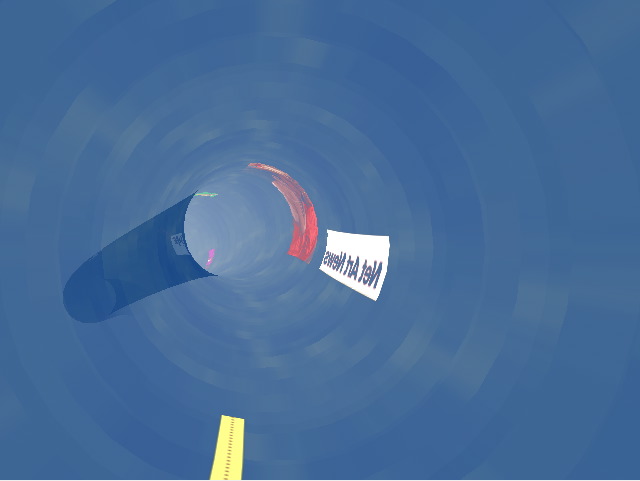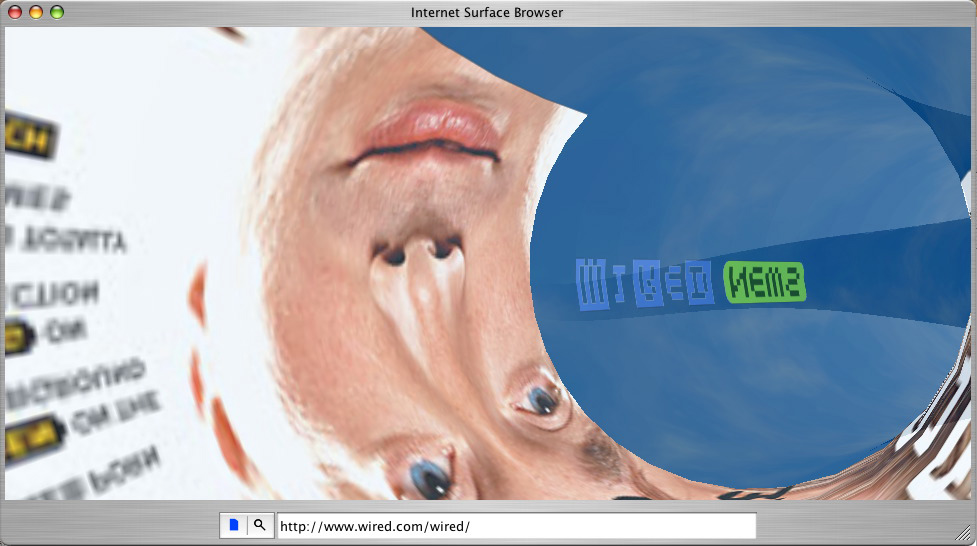
Surface Browser
Tim Plaisted 2003, 2004, 2025
Surface Browser represents the cumulative experience of net surfing as a deluge of images flowing into viewer perception. The software uses browser conventions (address bar, image search) as entry points to a spatial internet. It can run as a stand-alone app, gallery installation with audience input and/or run autonomously based on sites and key words relevant to the installation. It manifests the imagined virtual as a liquid space, remapping the static visual media of the net into an environment that can be entered and traversed.
Full statement below.
Images
Image Search "Art News" (and BW version)
Browsing Site "Wired"
Installation shot 2004: Australian Culture Now, Australian Centre for the Moving Image
Movies
Sequence 1: Automatic browsing: image search followed by box c site (15 seconds)
Sequence 2: Automatic browsing: News images (7 seconds)
Sequence 3: Current work (with test image). (43 seconds)
Movies encoded in Quicktime MPEG4.
Credits
Surface Browser
Tim Plaisted 2003, 2004, 2025
Ryan Hodge - Application Framework Design, Rendering Programmer
Nick Kaltner - Network Programmer
Rationale
Popular evocations of technology converged in the eighties and nineties on the idea of cyberspace to represent the time and space inside the network and to encapsulate images of a data-centric, technological future. With the roll-out of internet technology beyond institutions to the public, many early metaphors related this to water: web surfing, streaming media and data pipes, with the mediated experience often being far from fluid! The piece looks at manifesting the virtual as this (blue) liquid/visceral space.
Surface Browser combines this archetype of popular imagination and browser conventions, the address bar and an image search, as entry points to traverse a spatial internet in order to reflect on the user ex perience of browsing. Surface Browser remaps the visual internet into space that can be entered and traversed. It represents the cumulative experience of surfing the internet as a deluge of images flowing into viewer perception.
Surface Browser works on this level of the imagination (the location of understanding of the virtual)* and experience rather than on a functional/programatic approach to a data visualisation interface. It gives volume and form to the evolving spaces of the internet; its semi-random paths map out arcs of potential pulling in the new, twisting and drawing in upon themselves, presenting an evolving representation of the internet and a way to explore its surfaces.
The piece is written in cross-platform languages, OpenGL and Java, allowing it to install directly from the web and run as a standalone piece of software on a majority of operating systems on the viewer's computer (the context for viewers' reception of the internet). It employs the available technology of OpenGL hardware acceleration in modern gaming video cards to render in realtime 3d. The piece can take viewer input or runs autonomously, based on sites and keywords relevant to the exhibition.
I am interested in representing the experience of browsing the internet, exploring ways of looking at the pages and images which give them depth and a way to explore their surfaces. This is not a case of creating independent and static virtual 3d worlds (VR, VRML) but about remapping the evolving visual aspect of the internet into an environment that can be entered and traversed. In this way, the solids representing pages can be seen as a way to give volume back to the millions of body images which make up so much of internet network traffic.
* Ideas of manifesting the virtual draw on Massumi's writings.
Key technologies
Java
- Cross-platform programming language.
OpenGL - Cross-platform standard
for 3D rendering and 3D hardware acceleration.
GL4Java, JOGL- OpenGL
binding library for Java.
Other Work in the Field
Browser Gestures,
Mark Daggett, 2001 (Browser intervention)
REWOB Screensaver, Hisayoshi Tohsaki, 2000 (Image montage from net traversal)
Netomat, Maciej Wisniewski, 1999 (Experimental browser)
Related:
3D Visualisation of information: Hot Sauce - Apple, IRIS/IRIX file system -
SGI (both mid 90's)
3D environments and Virtual Reality - also see VRML and 3D games patches Quake,
Half Life
Thanks
Thanks to the Maria Stark and The National Endowment for Science Technology and the Arts UK, Ryan Hodge, Nick Kaltner, Zoe Butt, Switch Media, Melinda Rackham and the team at ACMI, VR Solutions, The Tourists, Mathew Fletcher and Keith Plaisted.
